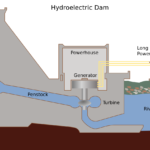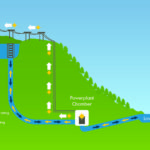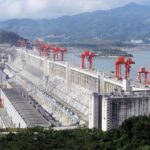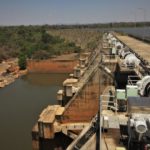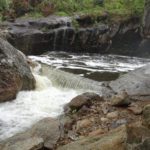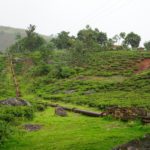Rivers are often referred to as lifelines as they bring the precious resource water even to remote places. Apart from the water being used for irrigation, washing, bathing, drinking, cooling etc. rivers provide kinetic (movement) and potential (height) energy which can be generated to electricity. This is done both on very small scale with wooden wind mills and on very big scale with huge dams.
All of the facilities add up to hydroelectricity being the currently most used source of renewable energies worldwide.
Hydro Electricity
Generally spoken the motion of the water turns a turbine which generates power. We can differentiate between three basic methods:
Conventional hydroelectric dams A dam stops the flow of the water so that a reservoir is created. A large pipe (called penstock) delivers water from the reservoir to the turbine. How much electricity can be generated depends on the volume of water and on the difference in height between the source and the outflow. | Pumped-storage hydroelectric stations Combining conventional hydroelectric with a pump makes the system more efficient as it adapts to change of demand. Here we have a second reservoir after the outflow. At times of low electrical demand the excess generation capacity is used to pump water up from the lower reservoir to the higher one. When there is high demand the water is released from the high reservoir and a lot of electricity can be generated. | Run-off-the-river hydroelectric stations
There is no reservoir or only a very small/natural existing one but the water coming from upstream is directly lead to the turbine. This way we can prevent the environmental impact associated with large-scale storage. The capacity we generate is subject to seasonal flow levels. |
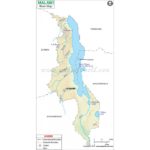
Anywhere you find a stream or a river, theoretically a hydropower stations can be implemented. With big rivers like the Congo River, the Zambezi, the Niger, the Nile and many smaller ones the hydropower resources in Africa are abundant. It is estimated that over 90% of technically feasible potential has still not been developed which means further expansion is possible. The main potential is found in Central Africa but other regions also have good resources.
Hydropower can be deployed on different size:
- Large-scale hydropower stations are the largest power producing facilities in the world, with some of them being double the size of the current biggest nuclear power facility. Hydropower is generally well-suited to meet large-scale industrial energy demand. As the technology is mature power production costs can be as low as 3 U.S. cent per kilowatt-hour (USD 0.03/kWh) which makes it an economical solution compared to other energy resources.
- Small hydro can be a good cost-effective opportunity for communities or single households for off-grid electricity. Some are so tiny that they only generate enough energy for some lights and a radio. See Mini Grid and Energy Kiosk for more inspiration.
However, what needs to be considered is that hydropower largely depends on climate and weather conditions. In times of drought when it does not rain for a long time the water levels of rivers go down, smaller ones even dry up completely. Less water flowing through the hydropower stations results in less power being generated. A perfect partner would be solar as usually the season when hydropower generation experiences its minimum solar provides a maximum (e.g. dry season).
As already mentioned hydropower is the current most deployed source of renewable energies. In 2015 70% of renewable electricity was generated from hydropower which is 16.6% of the world’s total electricity and hydroelectricity was expected to keep increasing with an annual rate of 3.1%. In Africa 28 GW of hydro capacity was installed which is a high rate compared to the installation of other renewable energies like solar of wind and still more big projects are under construction.
Malawi is largely dependent on hydropower. Nearly 95% of the total installed capacity is produced from hydro power plants that are mainly located along the Shire river. However, the generated electricity is not sufficient to meet the power demand of the country even though still only 11% of the population is connected to the national grid. Therefore, power supply is rationed by regular load-shedding which means the average household is left without electricity for 6 hours daily (so called blackouts).
During the dry season the situation worsens as the rivers do not get much supply of water. The reduced water flow sometimes pushes the capacity below 200MW. Climate change aggravates the situation further as extreme weather conditions become more common. The fast deforestation rate that Malawi experiences also plays a role here. Trees are an important part of the natural water cycle: their roots stabilize and structure the soil and therefore allow rain water to penetrate deep into the ground. Without trees the soil becomes dry, compacted and prone to soil erosion which then again leads to siltation of rivers and less water flow.
Nevertheless, the Malawian government expands hydropower and invests in new facilities. Installation of further hydropower plants such as Mpatamanga at the Shire river are among recent plans to ease the current power deficit.
Keep yourself updated on any relevant news related to renewable energies on the platform Conrema.org! 🙂
Generally spoken the motion of the water turns a turbine which generates power. We can differentiate between three basic methods:
Conventional hydroelectric dams
A dam stops the flow of the water so that a reservoir is created. A large pipe (called penstock) delivers water from the reservoir to the turbine. How much electricity can be generated depends on the volume of water and on the difference in height between the source and the outflow.
Pumped-storage hydroelectric stations
Combining conventional hydroelectric with a pump makes the system more efficient as it adapts to change of demand. Here we have a second reservoir after the outflow. At times of low electrical demand the excess generation capacity is used to pump water up from the lower reservoir to the higher one. When there is high demand the water is released from the high reservoir and a lot of electricity can be generated.
Run-off-the-river hydroelectric stations
There is no reservoir or only a very small/natural existing one but the water coming from upstream is directly lead to the turbine. This way we can prevent the environmental impact associated with large-scale storage. The capacity we generate is subject to seasonal flow levels.

Anywhere you find a stream or a river, theoretically a hydropower stations can be implemented. With big rivers like the Congo River, the Zambezi, the Niger, the Nile and many smaller ones the hydropower resources in Africa are abundant. It is estimated that over 90% of technically feasible potential has still not been developed which means further expansion is possible. The main potential is found in Central Africa but other regions also have good resources.
Hydropower can be deployed on different size:
- Large-scale hydropower stations are the largest power producing facilities in the world, with some of them being double the size of the current biggest nuclear power facility. Hydropower is generally well-suited to meet large-scale industrial energy demand. As the technology is mature power production costs can be as low as 3 U.S. cent per kilowatt-hour (USD 0.03/kWh) which makes it an economical solution compared to other energy resources.
- Small hydro can be a good cost-effective opportunity for communities or single households for off-grid electricity. Some are so tiny that they only generate enough energy for some lights and a radio. See Mini Grid and Energy Kiosk for more inspiration.
However, what needs to be considered is that hydropower largely depends on climate and weather conditions. In times of drought when it does not rain for a long time the water levels of rivers go down, smaller ones even dry up completely. Less water flowing through the hydropower stations results in less power being generated. A perfect partner would be solar as usually the season when hydropower generation experiences its minimum solar provides a maximum (e.g. dry season).
As already mentioned hydropower is the current most deployed source of renewable energies. In 2015 70% of renewable electricity was generated from hydropower which is 16.6% of the world’s total electricity and hydroelectricity was expected to keep increasing with an annual rate of 3.1%. In Africa 28 GW of hydro capacity was installed which is a high rate compared to the installation of other renewable energies like solar of wind and still more big projects are under construction.
Malawi is largely dependent on hydropower. Nearly 95% of the total installed capacity is produced from hydro power plants that are mainly located along the Shire river. However, the generated electricity is not sufficient to meet the power demand of the country even though still only 11% of the population is connected to the national grid. Therefore, power supply is rationed by regular load-shedding which means the average household is left without electricity for 6 hours daily (so called blackouts).
During the dry season the situation worsens as the rivers do not get much supply of water. The reduced water flow sometimes pushes the capacity below 200MW. Climate change aggravates the situation further as extreme weather conditions become more common. The fast deforestation rate that Malawi experiences also plays a role here. Trees are an important part of the natural water cycle: their roots stabilize and structure the soil and therefore allow rain water to penetrate deep into the ground. Without trees the soil becomes dry, compacted and prone to soil erosion which then again leads to siltation of rivers and less water flow.
Nevertheless, the Malawian government expands hydropower and invests in new facilities. Installation of further hydropower plants such as Mpatamanga at the Shire river are among recent plans to ease the current power deficit.
Keep yourself updated on any relevant news related to renewable energies on the platform Conrema.org! 😊

